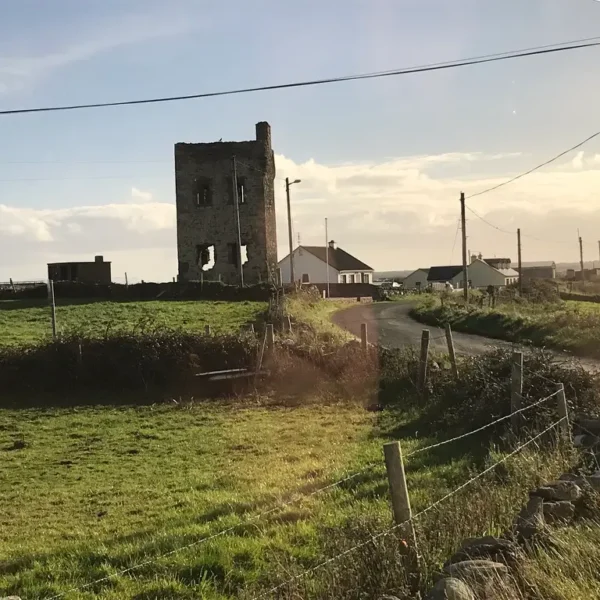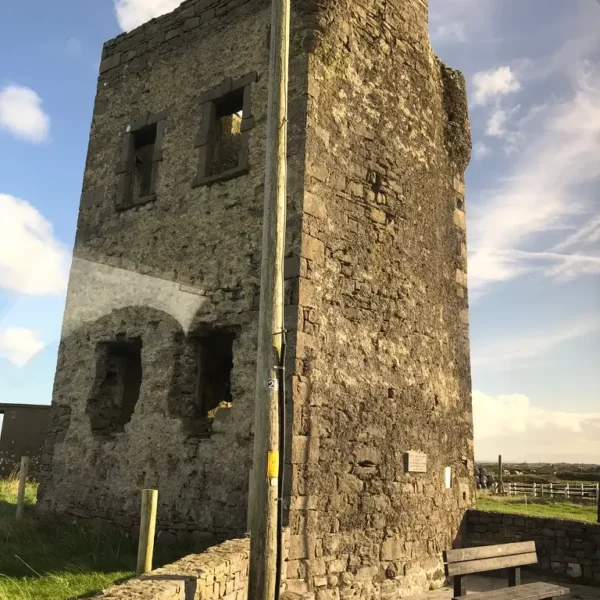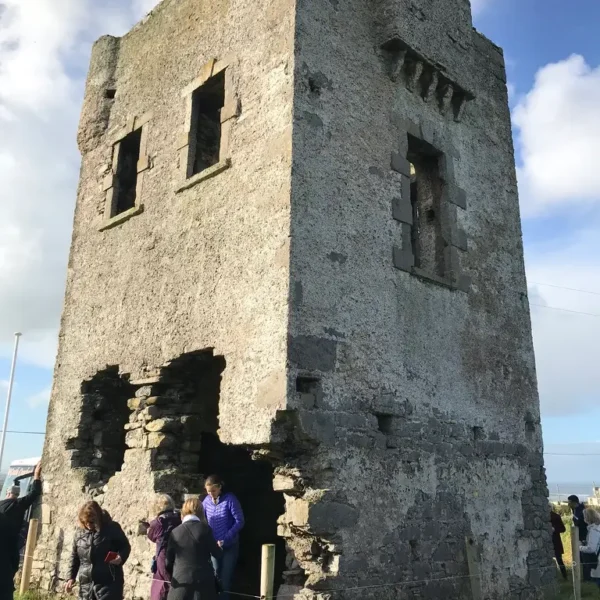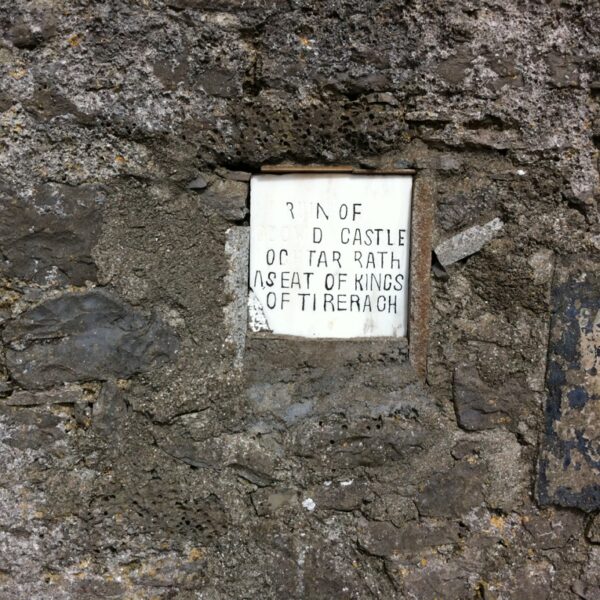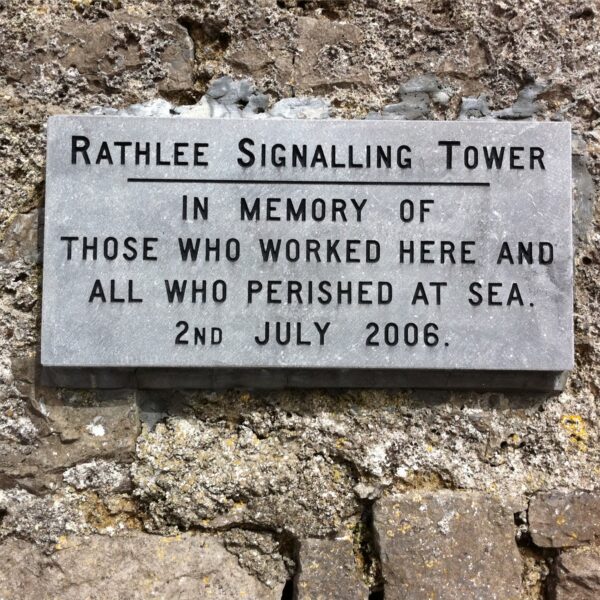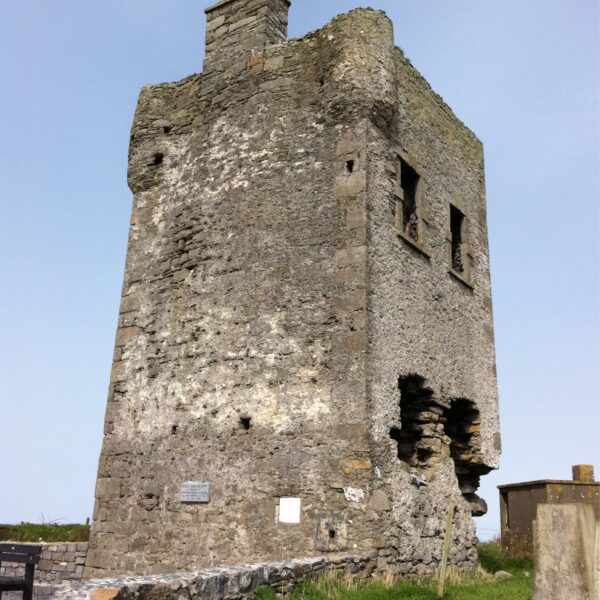Rathlee Castle
January 21, 2025 2025-07-10 3:16Rathlee Castle
Rathlee Castle
A Sentinel of O’Dubhda Heritage in Tireragh
Nestled in the heart of our ancestral lands, Rathlee Castle stands as a testament to Ireland’s rich medieval heritage and the enduring legacy of the O’Dubhda clan. Though perhaps not as widely known as some of Ireland’s grander castles, Rathlee Castle holds a fascinating story that reflects our clan’s complex history of resilience, territorial influence, and unwavering connection to the lands of Tireragh. For generations, this stronghold has borne witness to the ebb and flow of power, serving as a silent guardian of our past and a symbol of our enduring presence in this storied landscape.
I. Overview: Rathlee Castle – A Stronghold Woven into Our Clan’s Tapestry
Rathlee Castle, located in what was once the heartland of our O’Dubhda territory in Tireragh, County Sligo, is more than just stone and mortar; it is a tangible link to our clan’s storied past. Its strategic position, overlooking the surrounding lands, underscores its importance in the medieval landscape. While its initial construction may be attributed to Norman hands, its history soon intertwines with the O’Dubhda clan, who, as the dominant Gaelic power in Tireragh, asserted control over such vital strongholds.
Our clan, the Ó Dubhda (or O’Dowd), were the hereditary rulers of Tireragh (Tír Fhíacrach) and the Barony of Erris, areas synonymous with our influence for centuries. This established dominance means that Rathlee Castle, situated firmly within our traditional domain, is inherently connected to our history. Historical records explicitly confirm this connection, noting that “Rathlee Castle was one of the many O’Dowd castles—the rulers of Tireragh Baroney until about 1450 AD”. This direct association provides compelling evidence of our clan’s long-standing presence and authority at this site.
The historical accounts of Rathlee Castle, initially constructed by Normans yet later serving as an O’Dubhda stronghold, illustrate a common pattern in medieval Ireland: the dynamic nature of castle ownership. The 13th century saw significant Norman expansion, with families like the de Burghs building defensive strongholds such as Rathlee Castle. However, the Gaelic clans, including our own O’Dubhda ancestors, were far from passive. Our chieftains were “at constant war with the English to defend his territory”. This constant struggle meant that castles frequently changed hands, reflecting the ongoing contest for control over land and resources. A Norman-built castle becoming an O’Dubhda stronghold by the 15th century is a testament to the resilience and territorial power of the Gaelic chieftains. Rathlee Castle’s story, therefore, becomes a microcosm of the larger Gaelic-Norman struggle for control, where our clan played a pivotal role in defending and holding our ancestral lands against external pressures.
II. The Storied Past: Rathlee Castle Through the Ages and the O’Dubhda Presence
The history of Rathlee Castle is a chronicle of conflict, control, and eventual decline, all set against the backdrop of our clan’s enduring presence in Tireragh.
A. Origins and Early History: Norman Foundations and Gaelic Aspirations
Rathlee Castle’s origins trace back to the 13th century, a period marked by significant Norman expansion across Ireland. It was initially constructed as a defensive stronghold, strategically positioned to oversee and protect the surrounding lands within our ancestral territory. While historical records suggest the castle was built by a prominent Norman family, likely the de Burghs, it is crucial to remember that this construction occurred within the traditional O’Dubhda heartland of Tireragh. Our clan, the Ó Dubhda, were the established rulers of this barony until at least 1450 AD. This indicates that the castle, regardless of its initial builders, became a key asset within our clan’s sphere of influence, either through conquest, strategic alliance, or subsequent acquisition. The very name of the castle, derived from the Irish “Ráth Lios,” translates roughly to “Fort of the Ringfort,” hinting at an even older Gaelic settlement on the site. This linguistic connection reinforces the deep indigenous roots of the land upon which the castle stands, predating both Norman and even our clan’s formal establishment.
B. Rathlee in the Gaelic and Norman Conflicts: A Clan Stronghold
As tensions escalated between the native Gaelic Irish clans and the Norman settlers throughout the 14th and 15th centuries, Rathlee Castle became a focal point of frequent skirmishes. It changed hands multiple times, a testament to the fierce competition for control of this strategically vital territory. Our O’Dubhda ancestors, who were at constant war with the English to defend their territory, would have been deeply involved in these struggles. The fact that the O’Dubhda were the rulers of Tireragh Barony until approximately 1450 AD strongly implies that Rathlee Castle was under our clan’s control for significant periods during these turbulent centuries. Our chieftains would have garrisoned it, defended it, and used it as a base for projecting their power. Local legends speak of heroic battles fought at the castle, where defenders skillfully utilized the natural landscape. It is understood that many of these defenders would have been our own O’Dubhda warriors, fighting to protect their homeland and their chieftain’s seat.
The transformation of a Norman structure into a Gaelic stronghold, and its repeated changing of hands, illustrates the adaptability of Gaelic clans like the O’Dubhda. Rather than solely relying on traditional ringforts or older fortifications, our ancestors integrated and utilized Norman-style castles, which were more formidable against contemporary siege warfare. This is further evidenced by the mention of Norman castles being built in O’Dubhda territory at places like Ardnarea, Castleconor, and Enniscrone. Rathlee Castle, therefore, symbolizes not just a battleground, but also the O’Dubhda clan’s strategic acumen in adopting and leveraging new military architecture to defend our ancestral lands against both Norman incursions and, later, English expansion. It represents a continuous struggle for sovereignty, where the castle became a tangible representation of our clan’s enduring presence and power in the region.
C. The Tudor Period and Decline: Resilience Amidst Upheaval
The 16th century brought profound political and religious upheaval under Tudor rule, and Rathlee Castle, like countless other strongholds across Ireland, found itself caught in the crossfire. Our clan, deeply rooted in the traditional Catholic faith and Gaelic customs, would have resisted English rule, leading to severe consequences. The castle’s owners, likely our O’Dubhda kinsmen or their allies, faced confiscation of their estates, which were then redistributed to Protestant settlers during the Plantations of Ireland. This marked a significant period of decline for many Gaelic lordships, including our own. By the 17th century, the castle had begun to fall into disrepair, its military significance waning with the advent of cannon fire, which rendered smaller castles obsolete. While Rathlee was later granted to an Ormsby in 1691, this post-dates the primary period of O’Dubhda control mentioned in historical accounts (until approximately 1450 AD). This transition reflects the broader pattern of land confiscation and redistribution that severely impacted Gaelic families during the 17th century.
The decline of Rathlee Castle during the Tudor and 17th-century Plantations is a direct consequence of the systematic dismantling of Gaelic clan power. The confiscation of lands and redistribution to new settlers directly impacted the O’Dubhda clan’s ability to maintain their strongholds. Furthermore, the technological shift in warfare, making smaller castles vulnerable to cannon fire, removed their strategic value, accelerating their abandonment and decay. This period represents a profound rupture in our clan’s direct control over such fortifications, marking the end of an era where castles like Rathlee served as active symbols of O’Dubhda sovereignty. The physical decay of the castle thus mirrors the broader decline of traditional Gaelic power structures across Ireland.
III. Architectural Marvels: Unveiling Rathlee Castle’s Enduring Structure
Despite the ravages of time, Rathlee Castle retains features that offer a glimpse into its past and the ingenuity of its builders.
A. The Enduring Strength of the Keep and Curtain Walls
Though now largely in ruins, Rathlee Castle retains several notable architectural features that speak to its medieval construction. The central tower, or Keep, despite partial collapse, showcases classic medieval masonry techniques, a testament to the skill of the builders. Fragmented remains of the outer defensive Curtain Walls hint at the castle’s once formidable presence, designed to withstand both the elements and potential sieges. These features allowed it to serve its purpose as a strategic stronghold for those who held it, including our O’Dubhda ancestors during their periods of control.
B. Whispers of Hidden Passages: Underground Tunnels and Strategic Views
Intriguing features contribute to the castle’s mystique. Local lore speaks of hidden passages or Underground Tunnels used during sieges, some of which have been partially excavated in recent years. These elements suggest layers of defense and potential escape routes vital during times of conflict. Furthermore, the castle’s elevated site offers sweeping Views of the Landscape, emphasizing its strategic importance. From this vantage, our ancestors would have monitored their territory, observed approaching threats, and commanded the surrounding lands, making it an invaluable asset in their defense.
C. Rediscovery and Preservation: Honoring Our Ancestral Site
In the late 19th century, Rathlee Castle began to draw the attention of antiquarians and historians who recognized its historical significance. Archaeological surveys conducted in the 20th century uncovered artifacts like pottery and weapon fragments, providing insights into the lives of those who lived and fought within its walls. Today, efforts are focused on stabilizing its ruins and promoting it as a site of historical and cultural interest. These preservation endeavors are vital for the O’Dubhda clan, ensuring that this tangible link to our past remains for future generations to explore and understand.
For the O’Dubhda clan, the preservation of Rathlee Castle is not just about maintaining a historical structure; it is a profound act of reaffirming our identity and connection to our ancestral lands. In the wake of centuries of dispossession and cultural suppression, as hinted by the Tudor decline and Plantations, the active effort to stabilize and interpret sites like Rathlee Castle becomes a powerful statement of cultural reclamation. It allows us to physically connect with the spaces our ancestors inhabited and fought for, ensuring that their stories and our clan’s heritage are not lost to time. It transforms a ruin into a living monument of resilience, allowing descendants worldwide to connect with their roots.
IV. Legends and Lore: Tales from Rathlee Castle’s Shadows and Our Clan’s Echoes
Like many ancient Irish strongholds, Rathlee Castle is steeped in local folklore, adding layers of intrigue to its historical narrative.
A. The Norman Knight and Hidden Treasures
No Irish castle is complete without its share of folklore, and Rathlee Castle is no exception. Local tradition holds that the castle is haunted by the spirit of a Norman knight who bravely fell defending its walls. This tale, though perhaps apocryphal, highlights the intense conflicts that defined the castle’s history, conflicts in which our O’Dubhda ancestors were deeply embroiled. Locals also recount tales of hidden treasure buried beneath the castle, inspiring adventurers to seek their fortune in its shadow. These legends, while perhaps fantastical, speak to the castle’s enduring mystique and its deep integration into the local community’s collective memory, a community that has long lived within the historical shadow of O’Dubhda influence.
Beyond mere entertainment, these local legends serve as a vital, informal means of historical and cultural preservation. In a period where written records might have been scarce or controlled by opposing powers, oral traditions and folklore kept the memory of significant events, conflicts, and even the presence of different groups (like Norman knights) alive within the community. For the O’Dubhda clan, these stories, even if not directly about our ancestors, are part of the fabric of the land we ruled. They reflect the enduring human connection to these historical sites and ensure that the castle’s turbulent past, including the struggles that shaped our clan’s destiny, continues to resonate through generations, even if subtly.
V. The O’Dubhda Legacy: Our Enduring Connection to Rathlee and Tireragh
Rathlee Castle’s significance is amplified when viewed through the lens of the broader O’Dubhda clan history, a lineage stretching back over a millennium.
A. The O’Dubhda Clan: A Brief History of Our Ancestors
The O’Dubhda clan, or Ó Dubhda in its original Irish form, stands among Ireland’s oldest and most distinguished families. Our ancestral homeland was in the province of Connacht, primarily encompassing modern-day County Mayo and County Sligo. Our lineage traces back to the legendary High King of Ireland, Niall of the Nine Hostages, linking us to the influential Uí Néill dynasty. More directly, we descend from Fiachra, brother of Niall, and from Daithi, the last pagan King of Ireland, who, according to legend, was killed by lightning in 455 AD.
The O’Dubhds emerged as a distinct clan around the 10th century, establishing our power base in Tireragh (Tír Fhíacrach) and the Barony of Erris. These regions became synonymous with our rule and influence, providing the Kings of North Connacht. In early centuries, our clan was renowned for seafaring, essential for both trade and defense against threats like Norse incursions. We constructed strongholds along the coastline, with Enniscrone being our most famous fortress, but also including many others like Rathlee. As chieftains, the O’Dubhds were known for their leadership, courage, and their constant efforts to defend their territory. Our history is replete with accounts of defending our lands against Anglo-Norman invaders, as exemplified by Taithleach Muaidhe, who was “at constant war with the English to defend his territory” in the late 13th century. Our clan’s story is one of enduring resilience in the face of constant external pressures.
B. Rathlee Castle: A Symbol of Our Enduring Heritage
Rathlee Castle, despite its current state, stands as a powerful symbol of the O’Dubhda clan’s enduring heritage. It represents the strategic importance of our ancestral lands, the fierce determination of our forefathers to defend their territory, and the complex interplay of power that shaped medieval Ireland. For us, the descendants of the Ó Dubhda, Rathlee Castle is not merely a historical site; it is a tangible connection to the kings and chieftains who bore our name and shaped our destiny. It invites us to reflect on our past, honor our ancestors, and carry forward the legacy of resilience and pride that defines our clan.
For the global O’Dubhda diaspora, sites like Rathlee Castle serve as crucial anchors for identity and heritage. When physical ties to Ireland are distant, historical sites and the stories connected to them become powerful touchstones. By highlighting Rathlee Castle as “a symbol of our enduring heritage,” this report provides a focal point for descendants worldwide to connect with their roots, fostering a sense of belonging and continuity across generations and geographies. The castle becomes a shared ancestral memory, transcending its physical location to unite the clan.
VI. Visiting Rathlee Castle Today: A Glimpse into Our Shared Past
Rathlee Castle offers a unique opportunity to connect with Ireland’s medieval past and the enduring legacy of the O’Dubhda clan.
A. Location & Access
Rathlee Castle is nestled in the scenic countryside near Easkey, County Sligo, Ireland. As a historical ruin, the grounds are generally accessible during daylight hours. Visitors are encouraged to check local guides for any specific access restrictions or guided tour availability. Typically, there is no admission fee to explore the castle grounds.
B. What to Expect
Visitors to Rathlee Castle will find themselves immersed in a landscape steeped in history. Though largely in ruins, the remaining structures—the central keep, fragments of curtain walls, and the strategic views—offer a powerful glimpse into its medieval past. The site exudes an authentic charm, less grand than more famous castles but rich in the echoes of Ireland’s past and the struggles of our ancestors. It’s a place for quiet reflection and historical imagination.
C. Important Considerations
Visitors should wear sturdy shoes, as the terrain can be uneven. It is essential to respect the historical nature of the site and any private property boundaries. While in the area, visitors can also explore other historical sites in Easkey and Tireragh, many of which have connections to the O’Dubhda clan, such as Easkey Abbey and the O’Dowd Castle (Roslee Castle) near Easkey pier. By providing practical visitor information and encouraging exploration of nearby O’Dubhda-related sites, this report actively promotes experiential heritage tourism. Experiencing the physical landscape and ruins firsthand creates a more profound and lasting connection to the heritage, transforming abstract historical facts into a tangible, memorable journey for both clan members and general tourists. It reinforces the idea that the clan’s history is not just in books, but alive in the very stones of the land.
Conclusion
Rathlee Castle stands as a compelling monument to the turbulent yet resilient history of Ireland and, crucially, to the enduring legacy of the O’Dubhda clan. Its origins as a Norman stronghold, its subsequent integration into the O’Dubhda domain in Tireragh, and its eventual decline reflect the broader shifts in power and warfare that shaped our nation. The castle is not merely a collection of stones but a tangible link to our ancestors’ struggles, their strategic acumen, and their unwavering commitment to defending their territory.
The ongoing efforts to preserve Rathlee Castle are more than just archaeological undertakings; they are acts of cultural reclamation, allowing current and future generations of the O’Dubhda clan, both in Ireland and across the diaspora, to physically connect with their heritage. The legends surrounding the castle, whether of Norman knights or hidden treasures, further embed it within the local consciousness, ensuring its story continues to resonate. Rathlee Castle, therefore, serves as a powerful symbol of our clan’s deep roots, our historical resilience, and the continuous thread that connects our past to our present. It invites all who visit to step back in time and experience a place where the echoes of our ancestors still whisper through the ancient stones.
Rathlee Castle
Ráth Lios (Fort of the Ringfort)
54°16'49.0"N, 9°02'30.9"W
Rathlee townland
Near Easkey, County Sligo, Ireland
Tower House
Medieval Gaelic-Norman hybrid structure with curtain walls and central keep
c. 13th century (Originally by Norman family, likely de Burgh)
Later brought under O'Dubhda control in the 14th–15th centuries
Fell into ruin by 17th century
Abandoned due to cannon warfare and land confiscation
Exists today as ruins and archaeological site
Beside a rural road near Easkey
No official entrance or tours
Visitors may walk around the ruins respectfully
Stronghold within O'Dubhda-controlled Tireragh
Used by the clan until around 1450 AD
Strategic site in battles with Anglo-Norman and English forces
Served as a symbol of sovereignty for the Ó Dubhda chieftains
Rathlee Castle is a quiet yet powerful monument to the resilience of the O'Dubhda clan and the layered history of Gaelic Ireland. Preserved ruins and local legend connect us directly with a living memory of medieval leadership and defense in the west of Ireland.

